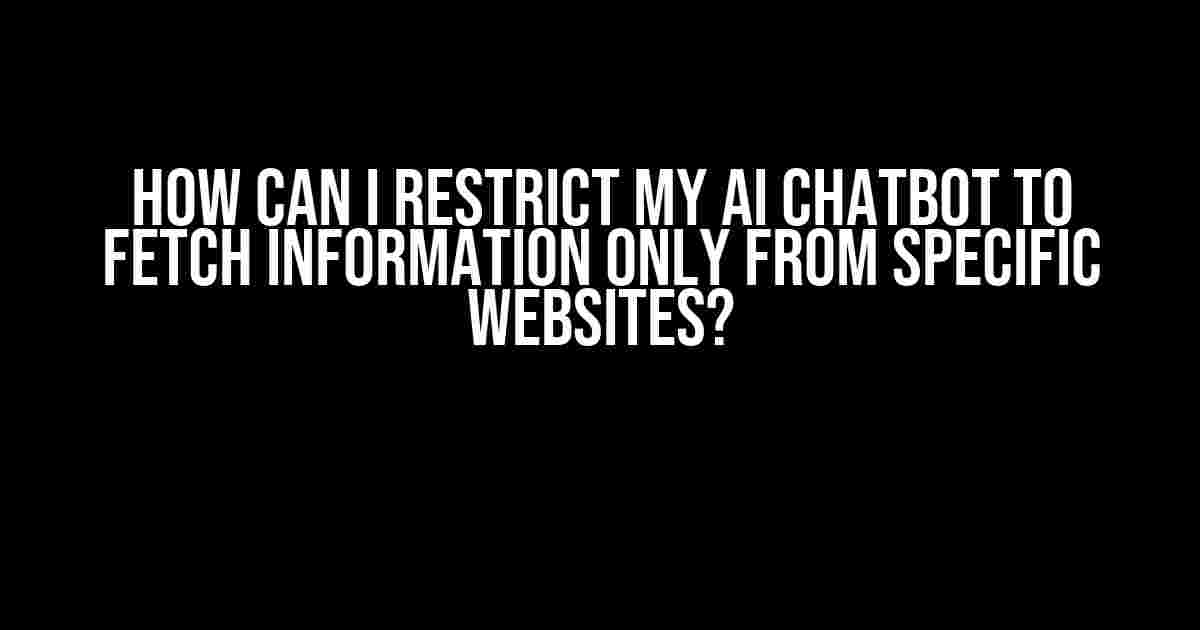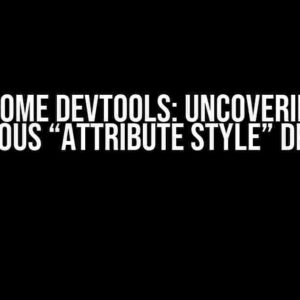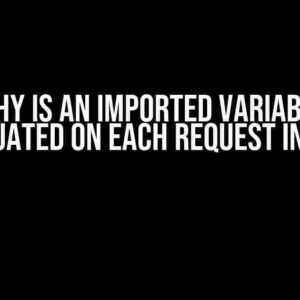Are you tired of your AI chatbot retrieving irrelevant or unreliable information from the vast expanse of the internet? Do you want to ensure that your chatbot provides accurate and trustworthy answers to user queries? The solution lies in restricting your AI chatbot to fetch information only from specific websites. In this article, we’ll guide you through the process of achieving this feat.
Why Restrict Your AI Chatbot’s Information Sources?
There are several reasons why restricting your AI chatbot’s information sources is essential:
- Improved Accuracy: By limiting your chatbot’s information sources to trusted websites, you can reduce the likelihood of providing inaccurate or outdated information.
- Enhanced Credibility: When your chatbot provides information from reputable sources, it enhances its credibility and builds trust with users.
- Better Relevance: Restricting your chatbot’s information sources helps to minimize the noise and irrelevant data, ensuring that users receive relevant and useful information.
- Reduced Risk of Misinformation: By avoiding untrusted sources, you can reduce the risk of your chatbot spreading misinformation or propaganda.
Methods to Restrict Your AI Chatbot’s Information Sources
There are several approaches to restrict your AI chatbot’s information sources to specific websites:
1. Whitelisting
Whitelisting involves specifying a list of trusted websites that your chatbot can fetch information from. This approach ensures that your chatbot only retrieves data from approved sources.
whitelist = ["https://www.wiki.com", "https://www.officialsite.com", "https://www.trustedsource.com"]
When implementing whitelisting, you can use regular expressions to match the approved websites. For example:
import re
whitelist = ["wiki.com", "officialsite.com", "trustedsource.com"]
pattern = re.compile("|".join(whitelist))
def fetch_info(url):
if pattern.search(url):
# Fetch information from the approved website
pass
else:
# Block access to unapproved websites
pass
2. Blacklisting
Blacklisting involves specifying a list of websites that your chatbot should avoid. This approach can be useful when you want to block specific websites or domains that are known to provide unreliable information.
blacklist = ["https://www.spamwebsite.com", "https://www.misinformation.com"]
When implementing blacklisting, you can use regular expressions to match the blocked websites. For example:
import re
blacklist = ["spamwebsite.com", "misinformation.com"]
pattern = re.compile("|".join(blacklist))
def fetch_info(url):
if pattern.search(url):
# Block access to blacklisted websites
pass
else:
# Fetch information from the website
pass
3. Domain Filtering
Domain filtering involves specifying a list of approved domains that your chatbot can fetch information from. This approach is useful when you want to restrict your chatbot to a specific set of domains or subdomains.
approved_domains = ["wiki.com", "officialsite.com", "trustedsource.com"]
When implementing domain filtering, you can use regular expressions to match the approved domains. For example:
import re
approved_domains = ["wiki.com", "officialsite.com", "trustedsource.com"]
pattern = re.compile("|".join(approved_domains))
def fetch_info(url):
if pattern.search(url):
# Fetch information from the approved domain
pass
else:
# Block access to unapproved domains
pass
4. Content Filtering
Content filtering involves specifying a set of rules to filter out unwanted or irrelevant content from the fetched information. This approach is useful when you want to remove unnecessary data or noise from the retrieved information.
import re
# Define a list of unwanted keywords
unwanted_keywords = ["spam", "advertisement", "clickbait"]
def filter_content(text):
for keyword in unwanted_keywords:
if re.search(keyword, text, re.IGNORECASE):
# Remove the unwanted content
pass
return text
Implementing Information Retrieval with Python
In this section, we’ll demonstrate how to implement information retrieval with Python using the `requests` and `BeautifulSoup` libraries.
Step 1: Send an HTTP Request
Use the `requests` library to send an HTTP request to the specified website:
import requests
url = "https://www.wiki.com"
response = requests.get(url)
Step 2: Parse the HTML Content
Use the `BeautifulSoup` library to parse the HTML content of the webpage:
from bs4 import BeautifulSoup
soup = BeautifulSoup(response.content, 'html.parser')
Step 3: Extract the Relevant Information
Use the `BeautifulSoup` library to extract the relevant information from the parsed HTML content:
information = []
for paragraph in soup.find_all('p'):
information.append(paragraph.text)
Best Practices for Restricting Your AI Chatbot’s Information Sources
To ensure the effectiveness of restricting your AI chatbot’s information sources, follow these best practices:
| Best Practice | Description |
|---|---|
| Regularly Update Your Whitelist/Blacklist | Regularly review and update your whitelist or blacklist to ensure that your chatbot stays relevant and accurate. |
| Monitor User Feedback | Monitor user feedback and adjust your chatbot’s information sources accordingly to improve its accuracy and relevance. |
| Use multiple Information Sources | Use multiple information sources to provide a more comprehensive and accurate answer to user queries. |
| Avoid Over-reliance on a Single Source | Avoid over-reliance on a single information source to minimize the risk of misinformation or bias. |
Conclusion
Restricting your AI chatbot’s information sources to specific websites is crucial for providing accurate, reliable, and relevant information to users. By implementing whitelisting, blacklisting, domain filtering, and content filtering, you can ensure that your chatbot fetches information only from trusted sources. Remember to follow best practices and regularly update your chatbot’s information sources to maintain its credibility and accuracy.
By following the instructions and explanations provided in this article, you can successfully restrict your AI chatbot’s information sources and provide better user experiences. Happy coding!
This article has provided a comprehensive guide on how to restrict your AI chatbot’s information sources to specific websites. From understanding the importance of information source restriction to implementing whitelisting, blacklisting, domain filtering, and content filtering, we’ve covered it all. If you have any further questions or need more information, feel free to ask!
Remember, restricting your AI chatbot’s information sources is just the first step towards providing excellent user experiences. Continuously monitor user feedback, update your chatbot’s information sources, and refine its algorithms to ensure that it remains accurate, reliable, and trustworthy.
Frequently Asked Question
Get the inside scoop on how to restrict your AI chatbot to fetch information only from specific websites!
Can I restrict my AI chatbot to fetch information only from specific websites?
Ah-ha! Yes, you can! By implementing a custom web scraping engine or using Natural Language Processing (NLP) techniques, you can train your AI chatbot to fetch information from specific websites. This can be done by configuring the chatbot’s algorithm to prioritize or exclusively fetch data from a whitelist of approved websites.
How do I specify the websites I want my AI chatbot to fetch information from?
Easy peasy! You can create a whitelist of approved websites by adding their URLs to your chatbot’s configuration file or database. For example, if you want your chatbot to fetch information only from Wikipedia and BBC News, you can add these URLs to the whitelist. This way, your chatbot will only consider these websites as trusted sources of information.
Will my AI chatbot still be able to answer questions if it can only fetch information from specific websites?
Absolutely! By restricting your chatbot to fetch information from specific websites, you can actually improve its accuracy and relevance. This is because your chatbot will only consider trusted sources of information, reducing the likelihood of retrieving incorrect or outdated data. Additionally, you can train your chatbot to use its knowledge graph or internal database to answer questions, even if the information is not available on the specified websites.
Can I use AI techniques like Named Entity Recognition (NER) to restrict my chatbot’s information fetch?
You bet! AI techniques like Named Entity Recognition (NER) can be used to identify and extract specific entities like names, locations, and organizations from unstructured text data. By combining NER with your chatbot’s algorithm, you can restrict its information fetch to specific websites or domains. For instance, you can use NER to identify entities mentioned on a specific website and then use that information to retrieve relevant data from that website.
How can I ensure that my AI chatbot’s information fetch is always up-to-date and accurate?
Good question! To ensure that your chatbot’s information fetch is always up-to-date and accurate, you can implement a regular crawling or scraping schedule to update its knowledge graph or database. Additionally, you can use techniques like entity disambiguation and knowledge validation to verify the accuracy of the retrieved information. By doing so, you can ensure that your chatbot provides the most accurate and relevant answers to users’ questions.





